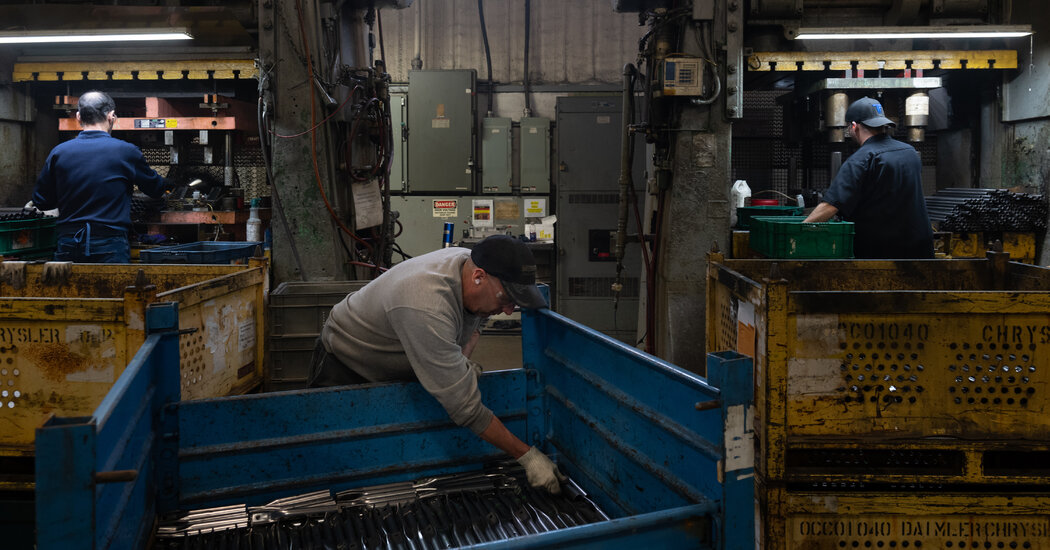Global Weekly Economic Update

Global Weekly Economic Update
The latest on the trade environment
- The United States is imposing a 25% tariff on all imports of steel and aluminum, regardless of the country of origin. The biggest suppliers of steel and aluminum to the United States are, in order, Canada, China, and Mexico, which are also the three largest trading partners of the United States. Canada is, by far, the largest supplier to the United States of aluminum. These three countries account for almost half of US imports of these two products. South Korea, Germany, and Brazil are also major suppliers. During the first Trump Administration, the United States imposed a 25% tariff on steel and aluminum but ultimately provided an exemption for imports from several countries, including Canada and Mexico.
The initial announcement of the tariffs led to an increase in metals prices and a decline in the equity prices of non-US steel and aluminum producers. Shares of US producers appreciated. The US imports about 23% of the steel consumed and about half of the aluminum consumed.
The European Union (EU) said that it will retaliate against the US tariffs. These tariffs are seen as potentially devastating to Europe’s steel industry. The EU has already proposed a 50% tariff on 4.8 billion euros of imports from the United States, including products such as whiskey, motorcycles, motorboats, and some steel and aluminum products. A final vote by the EU remains to take place. The EU Trade Commissioner said that “the EU sees no justification for the imposition of tariffs on our exports, which is economically counterproductive—especially given the deeply integrated production chains established through our extensive transatlantic trade and investment ties.” He proposed that there be negotiations. Meanwhile, the UK government said it will not retaliate. It hopes to avoid a trade war with the United States and enhance ties in technology, professional services, and financial services.
- US President Trump ordered the US government to develop a plan for reciprocal tariffs with the goal of reducing the US trade deficit. Reciprocal tariffs would mean that if another country imposes a higher tariff on US imports than the United States imposes on that country’s imports, then the United States should boost its tariffs accordingly. Moreover, reciprocity will apply not only to tariffs but also to VAT (value-added tax) rates. That is, President Trump wants US tariffs to offset the fact that other countries have higher consumption taxes than the United States. However, VATs are imposed on all goods, not just imported goods. As such, imported goods do not face a competitive disadvantage as a result of facing a VAT.
The President warned that many countries are at risk from his reciprocal tariff policy, including Japan, the EU, Brazil, and India. Trump said that “I’ve decided, for purposes of fairness, that I will charge a reciprocal tariff, meaning whatever countries charge the United States of America. In almost all cases, they’re charging us vastly more than we charge them, but those days are over.”
What does the tariff situation entail? The average effective tariff rate that some countries impose on imports from the United States is often different than the tariff imposed by the United States. Yet this is not a simple matter. For example, the average effective tariff that EU nations impose on imports from the US is 2.7%, while the average effective tariff the US imposes on EU imports is 2.2%. On the surface, this seems like a trivial difference. However, the tariffs vary by product. For example, the EU imposes a 10% tariff on imports of US vehicles, while the US tariff on EU vehicles is 2.5%. Thus, the President has threatened to impose a 10% tariff on vehicles from the EU. In response, some EU officials have suggested cutting the EU tariff to match that of the United States. If, however, the United States boosts the tariff on European vehicles to 10%, this will likely lead to higher prices for European vehicles sold in the United States.
The situation regarding Japan is interesting. Japan’s effective tariff on imports from the United States is only 1.9%, while the US tariff on Japanese imports is 1.4%—again, not a big difference. However, there are big differences when it comes to specific products. For example, Japan’s tariff on imports of US rice is 204.3%. Japan has long protected its rice farmers. The tariff on imported US meat is 23.3%. The US has high tariffs on sugar and on dairy products. It too has long protected sugar and dairy farmers. On the other hand, Japan’s tariff on imports of US automobiles is zero while the US tariff on Japanese cars is 1.9%. Given the US call for reciprocity, does this mean that the United States should lower its tariff on Japanese cars? That is not likely. In any event, the United States has not been clear as to whether reciprocity will involve average tariffs or tariffs on specific products.
With respect to China, the United States has already imposed substantial tariffs on imports from China, first in 2018 and now again in 2025. Although China has engaged in modest retaliation, the reality is that China’s average effective tariff on US imports is now lower than average US tariffs on China. Thus, under a reciprocal approach, the United States should lower tariffs on Chinese imports. Yet the US has offered other reasons to impose higher tariffs on China.
Moreover, the recent 10% tariff on Chinese imports imposed by the United States is far less than the 60% tariff that was discussed during the election campaign. Plus, since the first set of tariffs were imposed in 2018, trade relations have shifted dramatically. As recently as 2021, Chinese imports accounted for roughly 21% of US imports. That figure dropped to near 14% in 2024. This reflects companies redesigning supply chains to avert US tariffs on Chinese imports. Thus, inbound US company investment into China has fallen sharply, offset by rising investment elsewhere.
Finally, some emerging countries are highly exposed to the reciprocity effort by the United States. For example, the average effective tariff on US imports is 12% for India, 7% for Brazil, and 5% for Vietnam. These countries might be compelled to lower their tariffs to avoid higher US tariffs.
Notably, President Trump acknowledged that this policy could boost inflation in the United States. He said that “prices could go up somewhat short-term. But prices will also go down. What will go up is jobs. The jobs will go up tremendously.” That assumes that US consumers will replace imported goods with domestically produced goods. It also assumes that US exports will not be harmed by higher costs or retaliatory tariffs.
- During the Biden Administration, the Chips and Science Act was used to provide subsidies to foreign semiconductor manufacturers that invested in the United States. The goal was to encourage diversification of semiconductor production to reduce excessive dependence on Taiwan and China. The Trump Administration is taking a different approach with the same goal. It wants to eliminate the financial incentives and instead place tariffs on imported chips.
The shift in policy is of particular concern in Taiwan, where the world’s largest fabricator of semiconductors is located. It is currently making a huge investment in the United States with the help of US$6.6 billion in subsidies from the US government. If this subsidy is cut or withheld, it could affect the profitability of the investment, especially given that fabrication involves low margins. The high margins go to the customers that design the chips. There is also a geopolitical aspect to this situation. Taiwan is seen as strategically important to the United States given its role in producing high-end chips. If this is dissipated, Taiwan might worry about the US commitment to its security.
Finally, it is not clear what impact tariffs will have on import flows. Most of the chips produced in Taiwan are sent to countries other than the United States, where the chips are inserted into final products such as mobile telephones.
- In the months following the US election, there was a sharp rise in US bond yields and a sharp rise in the value of the US dollar against major currencies. This reflected investor expectations that a combination of tax cuts, tariffs, and immigration restrictions would boost inflation and lead the Federal Reserve to ease monetary policy more gradually, if at all. Since mid-January, however, bond yields have fallen and the value of the dollar has fallen or stabilized, especially against the Japanese yen, the British pound, the Canadian dollar, and several emerging market currencies. Why is this?
There are several possible explanations. First, many of the proposed tariffs have yet to be implemented, and there is now uncertainty about the future trajectory of tariffs. Rising tariffs generally lead to a higher-valued currency. Thus, less certainty about tariffs implies a lower-valued dollar. Second, investors might fear that tariffs will slow economic growth by reducing consumer purchasing power and hurting export competitiveness, thereby dampening inflationary pressure. Moreover, it seems less likely than previously that there will be tax cuts, which would both boost growth and potentially be inflationary. Consequently, bond yields have fallen, and futures markets’ implied probability of two interest rate cuts in 2025 has increased from a month ago. This, in turn, has influenced the value of the dollar.




